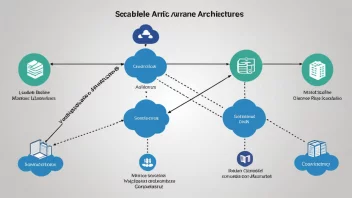The rapid advancement of cloud technologies has transformed numerous sectors, and personal finance and budgeting are no exceptions. With the increasing need for financial literacy and effective money management, more individuals are turning to cloud-based solutions to streamline their financial processes. This article delves into how cloud innovations are reshaping personal finance and budgeting, exploring the benefits, applications, and future trends.
Understanding Cloud Technology in Personal Finance
Cloud computing refers to the delivery of various services over the internet, including storage, processing, and analysis of data. In the context of personal finance, cloud technology enables users to access financial tools and resources from any device with an internet connection. This flexibility allows individuals to manage their finances in real-time, providing them with up-to-date insights into their spending habits and budgeting strategies.
Key Features of Cloud-Based Personal Finance Tools
Several key features characterize cloud-based personal finance tools:
- Accessibility: Users can access their financial data from anywhere, at any time, making it easier to monitor expenses and make informed decisions.
- Integration: Many cloud solutions seamlessly integrate with banking institutions, credit card companies, and investment platforms, allowing for a comprehensive view of one’s financial landscape.
- Real-time Updates: Users receive instant notifications about transactions and changes in their financial statuses, promoting proactive management.
- Collaboration: Cloud-based tools often allow for collaboration between users, such as family members or financial advisors, facilitating shared budgeting and financial planning.
Applications of Cloud Innovations in Personal Finance
Cloud technology has led to the emergence of various applications that cater to personal finance and budgeting needs. Here are some significant applications:
1. Budgeting Apps
Budgeting applications like Mint, YNAB (You Need A Budget), and PocketGuard leverage cloud technology to help users track their spending, set financial goals, and create budgets. These apps enable users to categorize expenses automatically and provide visual representations of their financial health.
2. Financial Aggregators
Financial aggregator platforms, such as Personal Capital, allow users to view all their financial accounts in one place. By linking bank accounts, investment accounts, and credit cards, users gain insights into their net worth, investment performance, and spending patterns.
3. Expense Tracking
Cloud-based expense tracking tools, like Expensify or Zoho Expense, help users record and categorize expenses efficiently. These applications often use OCR (Optical Character Recognition) technology to scan and digitize receipts, streamlining the process of expense management.
4. Tax Preparation
Cloud innovations have also impacted tax preparation, with software like TurboTax and H&R Block utilizing cloud services to facilitate the filing process. These tools help users gather financial information, calculate taxes owed, and ensure compliance with tax regulations.
Benefits of Cloud Innovations for Personal Finance
Utilizing cloud technology in personal finance offers numerous benefits:
1. Enhanced Security
While security concerns exist with cloud technology, reputable cloud finance platforms implement robust encryption and security protocols to protect user data. Regular software updates and compliance with industry standards help mitigate risks.
2. Cost-Effectiveness
Many cloud-based personal finance tools operate on a freemium model, allowing users to access basic features for free while offering premium services at a low cost. This accessibility encourages more individuals to engage in financial management.
3. Improved Financial Literacy
Cloud innovations often come with educational resources and tools that promote financial literacy. Users can learn about managing debt, saving for retirement, and investing through interactive content and personalized guidance.
4. Customization
Cloud-based tools often allow users to customize their experience according to their financial needs. Users can set specific goals, receive tailored advice, and adjust budgets based on personal circumstances.
Challenges and Considerations
Despite the numerous benefits, there are challenges associated with adopting cloud-based personal finance solutions:
1. Privacy Concerns
Privacy remains a primary concern for users of cloud finance tools. Sharing sensitive financial information with third-party services can lead to data breaches or misuse. It is crucial for users to research and select reputable platforms that prioritize data security.
2. Dependence on Internet Connectivity
Cloud solutions rely heavily on internet connectivity, which can be a disadvantage for users in areas with poor network access. Offline capabilities may be limited, restricting access to financial data when needed most.
3. Learning Curve
Some users may face a learning curve when transitioning to cloud-based finance tools. Familiarity with technology and software can impact one’s ability to utilize these tools effectively.
Case Studies: Real-World Applications of Cloud Innovations in Personal Finance
Case Study 1: Mint
Mint is a popular budgeting app that allows users to connect their bank accounts and track their spending effortlessly. By providing a comprehensive overview of financial health, Mint has helped millions of users better understand their finances. Users report that the app’s budgeting features enable them to save more effectively and reduce unnecessary expenses.
Case Study 2: YNAB (You Need A Budget)
YNAB is known for its proactive budgeting approach. The app encourages users to allocate every dollar they earn to specific spending goals. Users who adopt YNAB's methodology often report significant improvements in managing their finances, reducing debt, and achieving financial independence.
Case Study 3: Personal Capital
Personal Capital provides users with tools to manage investments and track net worth. By offering a holistic view of one’s finances, it enables users to make informed investment decisions and plan for retirement. Users appreciate the insights provided by Personal Capital, which help them optimize their investment portfolios.
The Future of Cloud Innovations in Personal Finance
The future of cloud innovations in personal finance looks promising. As technology continues to evolve, we can expect to see the following trends:
1. Artificial Intelligence and Machine Learning
AI and machine learning will increasingly play a role in personal finance tools, providing users with personalized advice and predictive analytics. These advancements will enable users to make more informed financial decisions based on their unique circumstances.
2. Enhanced Data Privacy Measures
As privacy concerns grow, we can expect cloud finance platforms to implement more stringent data protection measures. Users will benefit from increased transparency regarding how their data is used and stored.
3. Integration with Emerging Technologies
Future personal finance solutions may integrate with blockchain technology, enhancing security and transparency in transactions. This integration could pave the way for innovative financial products and services.
4. Focus on Financial Wellness
Cloud finance tools will increasingly prioritize users' overall financial wellness, offering resources and support for mental health and financial literacy. This holistic approach will empower users to develop healthier financial habits.
Conclusion
Cloud innovations have significantly transformed personal finance and budgeting, providing users with accessible, cost-effective, and powerful tools to manage their money. As we look ahead, the integration of advanced technologies and a focus on user privacy and financial wellness will further enhance these solutions. By embracing these innovations, individuals can gain greater control over their financial futures, ultimately leading to improved financial literacy and stability.






